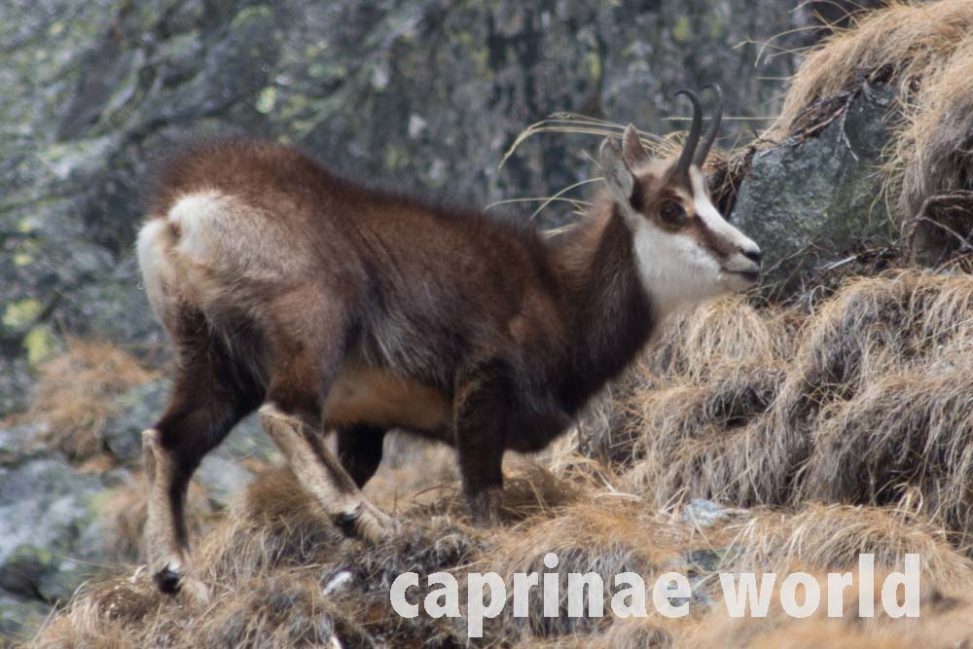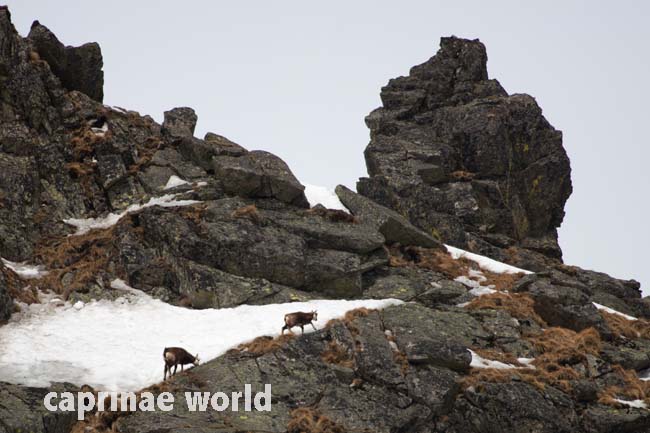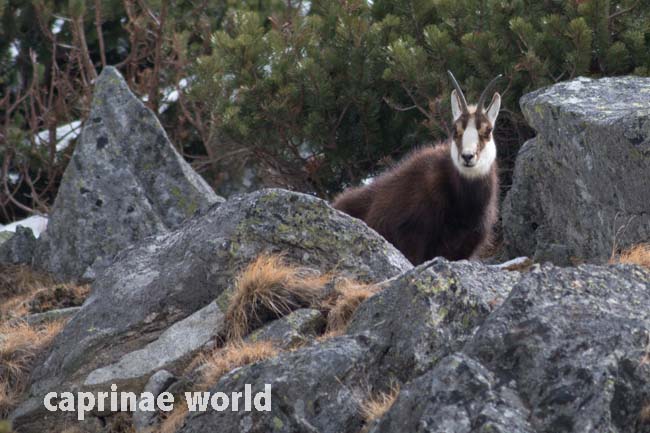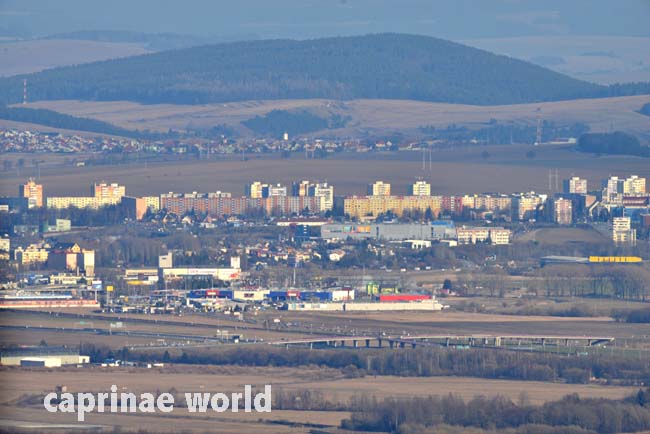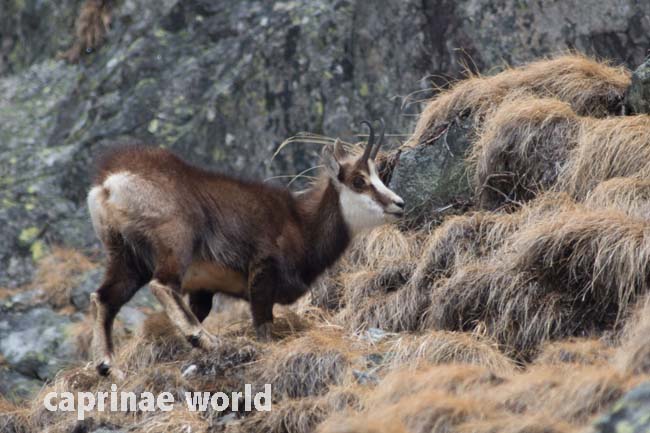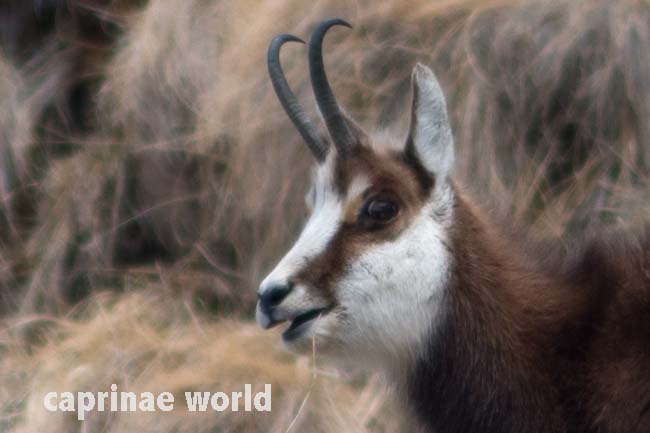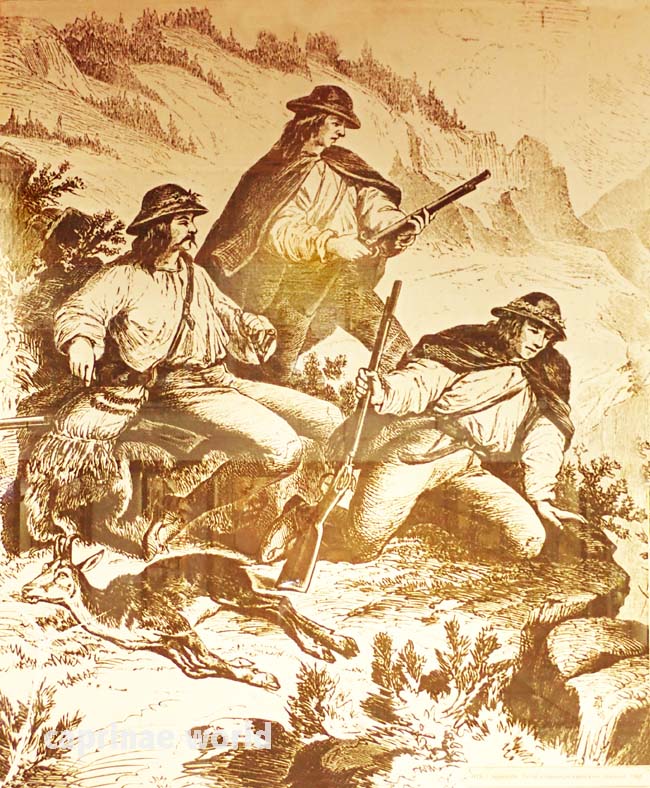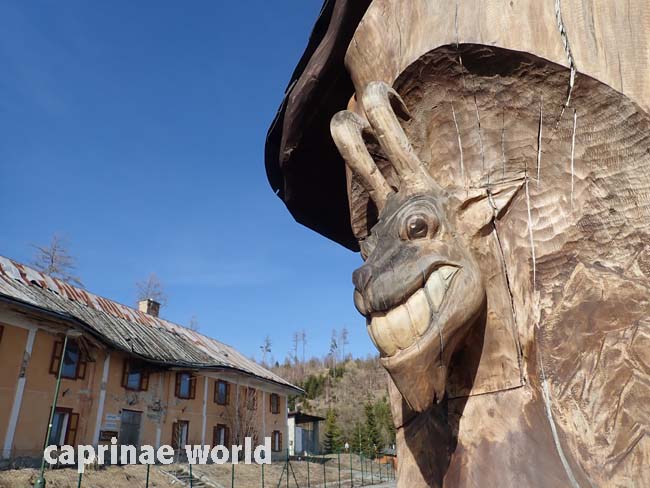The Tatra Chamois is treated as a subspecies of the Alpine Chamois. It has a very small and isolated distribution range in the Tatras Mountains on the border of Slovakia and Poland.
Names
Czech: Kamzík horský tatranský (Wikipedia)
English common name: Tatra Chamois (1, 3, 5)
French: Chamois des Tatras (1, 5)
German: Tatragams (1, 5), Tatra-Gämse
Italian: Camoscio dei Tatra (Wikipedia)
Polish: Tatra koziorozee, kozica (1), Kozica tatrzańska (Wikipedia), Kozica tatrzanska (5)
Slovak: Tatra kamzicia zver, kamzík horský (1); Kamzík vrchovský tatranský (Wikipedia, 5)
Spanish: Rebeco de Tatra (5), Rebeco de la Tatra (1)
Taxonomy
Rupicapra rupicapra tatrica
Blahout, 1972 (3)
Taxononmy is still not clear to date: Several authors consider the Tatra Chamois as a subspecies of the Alpine Chamois (Rupicapra rupricapra). (5) Couturier (1938) classified Tatra Chamois as belonging to the subspecies of the Carpathian Chamois (R. r. carpatica). Blahout (1972) separated the two phenotypes based on the completely different geographic location; he also used some differing cranial (scull) features to support the separation. Some authors consider these quantitative and qualitative characteristics as insufficient to justify subspecific status. (1)
In general Croves and Grubb (2011) state that they cannot comment on the distinctiveness of the Tatra Chamois, „which may or may not be different from the Alpine Chamois (the available measurements, however, are very different from those of the Carpathian Chamois).“
Nevertheless Croves and Grubb (2011) quote Hrabě and Koubek (1984) who found that the Tatra Chamois is larger than the Alpine Chamois. Again Croves and Grubb (2011) write that in Tatra Chamois (compared to the Alpine Chamois) the nasals (the bones that form the nasal ridge) are narrower in both sexes, and they are shorter in the males. (4)
But again the findings of Hrabe and Koubek (1985) are contradicting: stating that cranial measurements of Tatra Chamois are larger than those of the Alpine Chamois (R. r. rupicapra). (1)
The invariable use of alpine habitat above timberline is a distinctive behavioral feature of this subspecies. Tatra Chamois have never been observed in forest habitats. (5, 1)
Similar species/subspecies
In general the Tatra Chamois is similar to the Alpine Chamois. (5) The blackish winter coat of Tatra Chamois is similar to that of Alpine and Carpathian Chamois. (1)
Distribution
Tatras Mountains in South Poland and North Slowakia. (3)
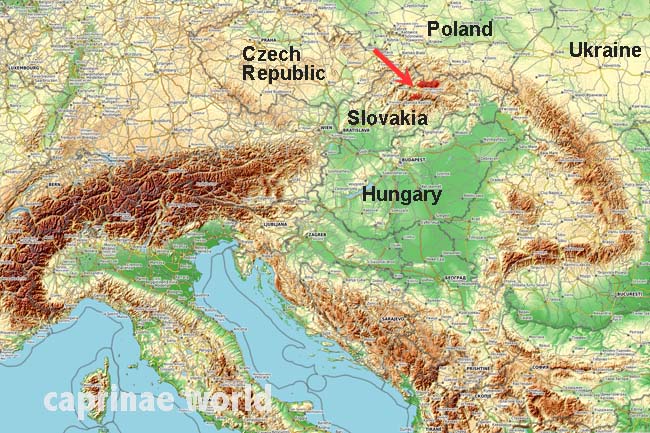
There are only two small distribution ranges for the Tatra Chamois – situated between the Alps and the Carpathians. Map Source: OpenTopoMap
Tatra chamois in the main distribution range are restricted to the High Tatras (Vysoké Tatry), the Western Tatras (Západné Tatry) and the Belianske Tatras (Belianske Tatry). Western and High Tatras are situated on both sides of the Slovakia-Poland-border. The smaller, only 15 kilometer long Belianske Tatras to the northeast of the High Tatras lie entirely within Slovakia. High Tatras and Belianske Tatras are devided by a high valley, but since the pass area is not wooded, an exchange between the two subpopulations should not be restricted.
This range represents the northernmost natural distribution limit of chamois in Europe, (1) infact it’s the northernmost natural distribution limit of chamois worldwide.
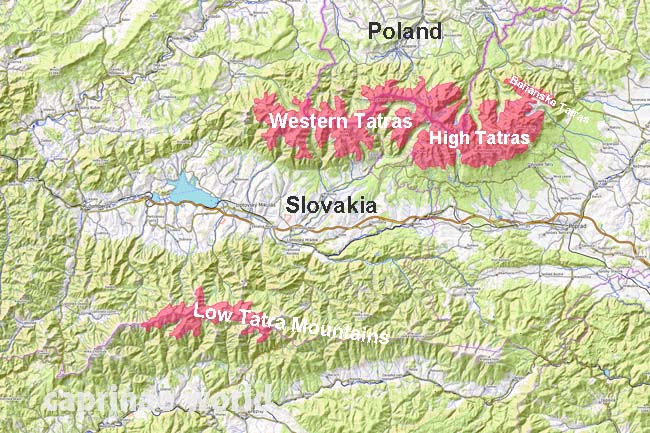
Location of the two Tatra Chamois distribution ranges within the four Tatras. Map source: OpenTopoMap
The second population occurs in Slovakia about 50 kilometers south from the High Tatras in the Low Tatra Mountains (Nízke Tatry) in and around Lomnistá Valley head and the Vajskovská Valley head.

Low Tatras with their more hilly character: Photo taken with a 800 mm lens from the High Tatras. Photo: Bürglin
The two distribution areas – High Tatras and Low Tatras – are separated by a populated valley both deep and wide. (1)
All distribution ranges of Tatra Chamois mentioned above – High Tatras, Western Tatras, Belianske Tatras, Low Tatras – lie within national park territories.
General discription
length / head-body: 110-130 cm (5)
shoulder height: 78-90 cm (1,5);
weight: average around 30 kg – range 25-36 kg (1); 24-36 kg (5)
horn length: 17-26 cm in males (5); average: 23 cm (1)
life expectancy: 14-22 years (5)
karyotype: 2n = 58 (1)
Colouration / pelage
overall body colour in winter: dark brown (5), blackish (1)
overall body colour in summer: rust yellow to reddish (1,5)
underside: pale (5)
legs: darker than body (5)
dorsal stripe: extending from the withers to the root of the tail (1, 5), also visible in the blackish winter coat. (1)
head: head mask with a white-yellowish coloration, more contrasting in winter (1, 5)
tail: dark, also clearly visible in the winter coat (5)
Horns
Both sexes have typical hooked chamois horns (1), with tips curving sharply backward and downward. (5) Average horn length is 23 cm with maximum lengths up to 26 cm. Base circumferences average 8 cm with a maximum 10 cm. (1) Horns of males are larger in girth than those of females. Horns of females can be longer, but are slimmer. (5)
Sexual dimorphism
Data is contradicting: Castelló (2016) writes „there is little“ (5). Croves and Grubb (2011) quote Hrabě and Koubek (1984) who found that sexual dimorphism was „considerable“. (4) In the field look for the horn hook, that can be considerably more pronounced in males than in females. Horns of females generally also have a smaller circumference. They appear thinner. To confirm a male also look for a tuft of hairs dangling between the hind legs.
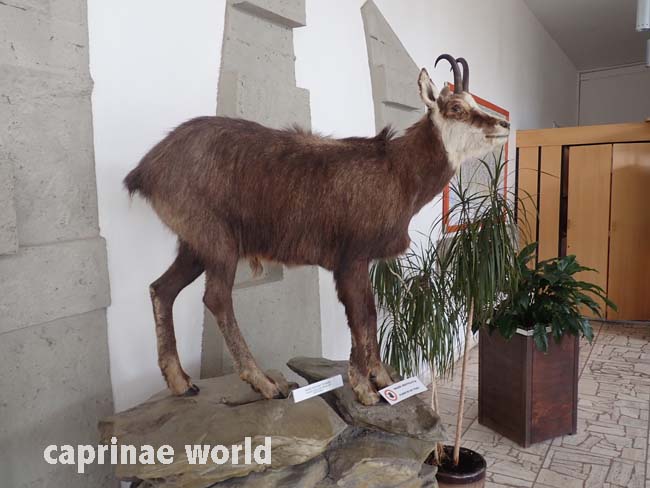
Stuffed male specimen in the Natural History Museum in Tatranská Lomnica. Note the stronger hooked horns and the tuft of penis hair, that can help to identify males in the field. Photo: Bürglin/High Tatras
Habitat
Tatra Chamois live above tree line at 1700 m (1), in open and semi-open alpine habitat, including alpine meadows, cliffs and boulder fields. Tatra Chamois have never been reported to sojourn in forest habitats. (5,1) They even avoid areas of dwarf pine, and also sheer rock faces, and sharp formations. (1)
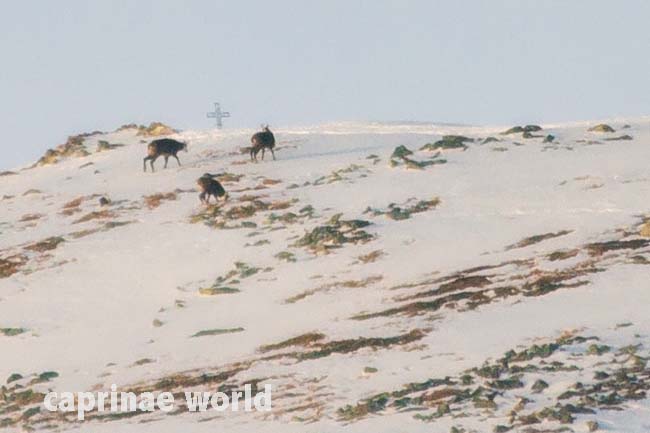
On April 3rd theses Tatra Chamois linger at this mountain peak and dig for dried gras under the snow. This is unusual for chamois. In other areas outside the Tatras chamois look for fresh green further down the slopes at this time of the year. Photo: Bürglin/High Tatras
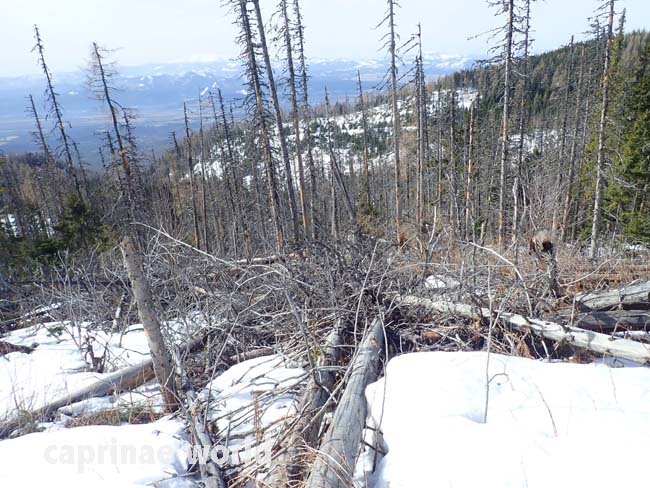
Forest with dead standing spruce and larch. Apparently Tatra Chamois do not enter these forests. Photo: Bürglin/High Tatras
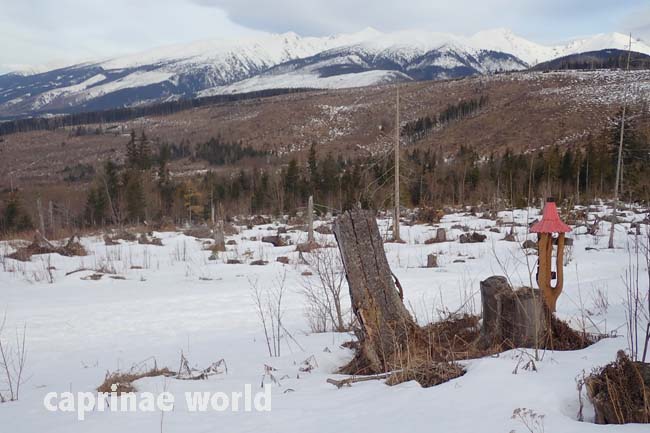
The lower slopes on the south side of the Tatras are very flat. Escaping would be difficult for chamois in this terrain. Photo: Bürglin/High Tatras
Predators
lynx (1,5), wolf (1,5), bear, fox (5), Golden Eagle (1)
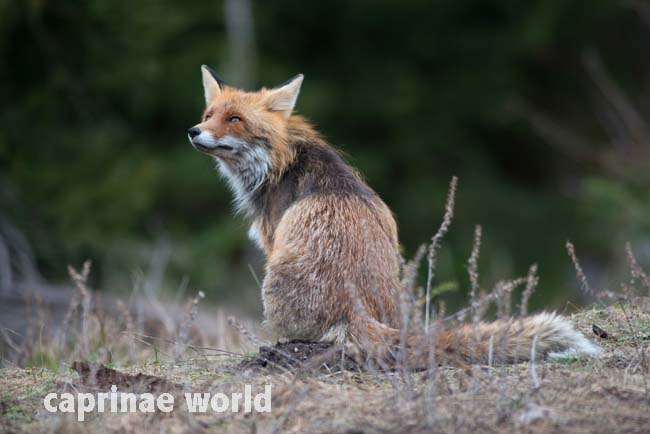
Foxes can predate on chamois. But probably they have rather newborns on their mind. Photo: Bürglin/High Tatras
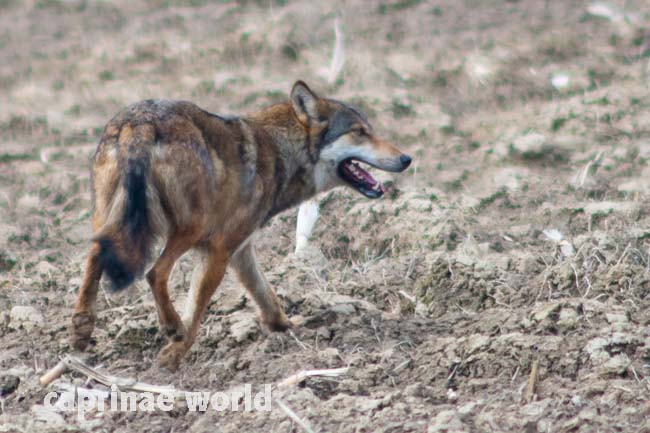
The presence of wolves may be the main reason why chamois do not enter the forests. Photo: Bürglin/High Tatras
Food and feeding
Both a browser and a grazer: grasses, leaves, buds, shoots, fungi (5)
Breeding
sexual maturity: 2,5 years females; 3,5-4 years males (5)
mating-season activity: no specific information available for this subspecies, but probably like other Alpine Chamois, with the rut beginning in the middle of October and ending in December. Males hardly eat during this time and live on accumulated fat reserves. During this season males join female herds and try to drive away other males. The risk of getting injured during fights is quite high and can lead to the death of one of the opponents. (5)
gestation: 170 days (5)
young per birth: one, rarely two (5)
weaning: 6 months (5)
Conservation Status / threats
The Tatra Chamois (R. r. tatrica) is listed as Critically Endangered (CR) C2a(ii) (2) – although numbers seem to increase in recent years.
Number of Tatra Chamois over time
| year | Slowakia | Poland | total / note | source |
| before World War II | 1200 |
Blahout 1975 in (1) |
||
| 1946 | 280 (Vysoké, Západné and Belianske Tatry) | (1) | ||
| since 1960s | numbers have been declining steadily until the end of the 20th century | Jurdíková, 2000 in (2) | ||
| 1999 | 220 | Jurdíková, 2000 in (2) | ||
| 2002 | below 200 | (2,1) | ||
| 2009 | 472 | 159 | 631 | (1) |
| 2010 | 513 | 207 | 800 | (1,5) |
| 2014 | 780 | (1) |
Usually 20 to 25 percent of the total number lives in the much smaller Polish area, with the rest on the Slowak side. (1)
Introduction of Tatra Chamois in the Low Tatras
Because of concerns of survivability of this subspecies in its native range, some 30 Tatra Chamois were introduced in the Low Tatras, situated south of the High Tatras, from 1969 to 1976 (1,5). The Low Tatras were selected because their geomorphologic and climatic conditions were closest to those of the High Tatras. (1) The current population living in the Low Tatras Nationalpark is about 100 (1,5). Fluctuations in the number of these animals is attributed to avalanches, predation, poaching, and an uncontrolled influx of tourists. (5) The Low Tatras National Park organizes a census every November. Further increase is not expected due to insufficient suitable habitat (rocky terrain) and predation. (1)
Introductions of Alpine Chamois in the Tatras
There are reports that a group of Alpine Chamois had been released in the 1930s by Prince Hohenlohe, a hunter and the former owner of large sections of Slovak Tatra. Between 1956 and 1960, Alpine Chamois were also introduced to the Vel’ká Tatra (1) („Vel’ká Tatra“ is most probably a misspelling; it should be Vel’ká Fatra – a mountain range that lies west of the Low Tatras.) This population increased to 52 individuals in 2005. In 1962, six more Alpine Chamois were introduced into the Slovensky raj Mountains (1) (probably east of the Low Tatras). Due to extensive damage to native vegetation, a total cull of these non-endemic animals has been proposed. There is also some possibility that these introduced Alpine Chamois hybridize with the Tatra Chamois from the Low Tatras. In any case, the purity of the Tatra Chamois should be maintained and any hybridization prevented. (1)
Major threats include poaching and disturbance and habitat loss caused by tourists. An estimated three million people visited Tatra National Park in 1990. In Slovakia, interbreeding with the above mentioned Alpine chamois threaten Tatra Chamois in the Low Tatras. Both populations – in the High Tatras and Low Tatras – are relatively small and their effective population sizes may make the maintenance of genetic diversity and adaptability limited over the long-term. (2)
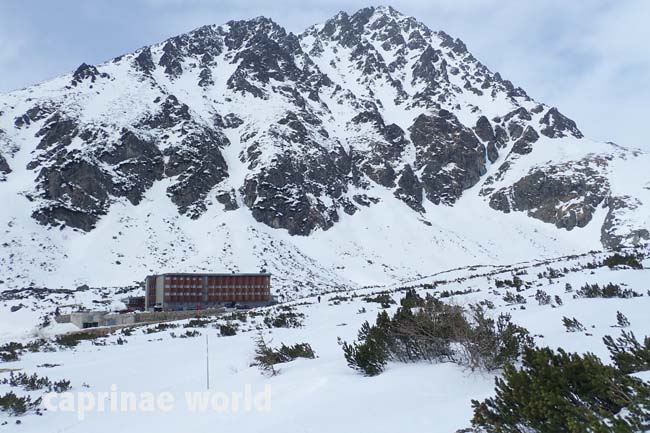
Three million people visit Tatra National Park each year. Instead of mountain huts national park authorities allow to build multistory buildings right in the core area of the national park. Some authors write that Chamois do suffer, but population numbers seem to rise too. Photo: Bürglin/High Tatras
To protect the High Tatras subspecies, Jurdíková (2000) recommends reducing illegal hunting by closing and guarding parts of the Western Tatras. Alpine Chamois introduced into the Lower Tatras should be removed as they pose a threat to the wild population of the Tatra Chamois (Shackleton 1997). (2,1) The populations in Slovak territory receive some supplementary forage and minerals like salt. (1)
Trophy hunting
Hunting Tatra Chamois has been strictly prohibited by law in Poland since 1868 and also in Slovakia. But the introduced Alpine Chamois is presently subject to the Slovak hunting law and usually five to seven hunting permits are allocated per year. (1) Nevertheless some tour operators sell these as Tatra Chamois to their clients.

Hunting Tatra Chamois is prohibited by law in Poland and Slovakia. Only the introduced Alpine Chamois can be hunted in the Low Tatras. Nevertheless some tour operators sell these as Tatra Chamois to their clients. Screenshot – altered
Ecotourism
The Tatra Chamois is the heraldic animal of the Slowakian Tatra Nationalpark. It is highly iconic, thematised on information boards. It is the first stuffed animal, that visitors get to see, when they enter the Natural History Museum in Tatranská Lomnica. The Tatra Chamois is also well presented on product labels and in advertisments in general. On my trip to Tatra Nationalpark in April 2018 it was the most easily observed mammal species. Having noted all this, it is also a fact that Tatra Chamois are hardly mentioned in wildlife watching trip reports, suggesting that they are so far not the reason to visit the area.
Literature Cited
(1) Damm, Gerhard R. and Franco, Nicolás, 2014: The CIC Caprinae Atlas of the World – CIC International Coucil for Game and Wildlife Conservation, Budakeszi, Hungary in cooperation with Rowland Ward Publications RSA (Pty) Ltd., Johannesburg, South Africa.
(2) Aulagnier, S., Giannatos, G. & Herrero, J. 2008. Rupicapra rupicapra. The IUCN Red List of Threatened Species 2008: e.T39255A10179647. http://dx.doi.org/10.2305/IUCN.UK.2008.RLTS.T39255A10179647.en. Downloaded on 10 April 2018.
(3) Wilson, D.E. and Mittermeier, R.A. [eds], 2011: Handbook of the Mammals of the World. Vol. 2. Hoofed Mammals. Lynx Edicions, Barcelona.
(4) Groves, Colin and Grubb, Peter, 2011: Ungulate Taxonomy. The John Hopkins University Press.
(5) Castelló, José R., 2016: Bovids of the World – Antelopes, Gazelles, Cattle, Goats, Sheep, and Relatives. Princton University Press.

